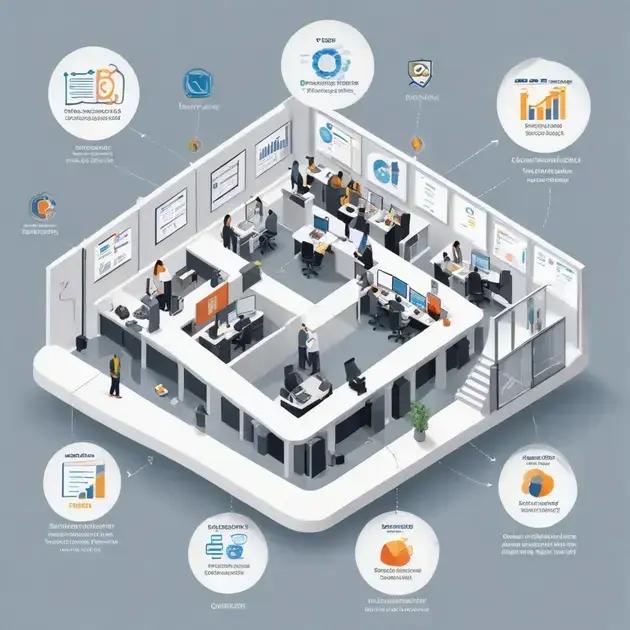A business management system is vital for streamlining operations, enhancing communication, and enabling data-driven decision-making. Key features include user-friendliness, project management tools, and integration capabilities, helping organizations improve efficiency and adapt to market changes effectively.
In today’s fast-paced environment, a business management system is crucial for streamlining operations. This technology not only boosts productivity but also enhances collaboration across teams. Understanding the fundamentals of these systems and their key benefits can greatly impact the success of any organization. In this article, we will explore what a business management system entails and why it’s an essential tool for modern businesses.
What is a Business Management System?
A business management system is a framework that allows organizations to streamline their processes and operations. It encompasses various tools and methodologies designed to help improve efficiency, communication, and productivity within a company.
Components of a Business Management System
Typically, a business management system integrates several components, including project management, resource planning, and tracking systems. These elements work together to provide a holistic view of operations, making it easier for managers to make informed decisions.
Types of Business Management Systems
There are various types of business management systems available, catering to different industries and organizational sizes. Common systems include Customer Relationship Management (CRM), Enterprise Resource Planning (ERP), and Content Management Systems (CMS). Each serves unique functions and can be tailored to specific business needs.
Role in Organizational Success
Implementing a business management system is crucial for achieving business goals. It helps organizations identify inefficiencies, enhance collaboration among teams, and increase overall productivity. Furthermore, it enables businesses to adapt quickly to market changes and customer demands, ensuring they remain competitive.
Key Benefits of Implementing a Business Management System

Implementing a business management system offers numerous advantages that can significantly enhance an organization’s performance. These benefits can lead to improved efficiency, better resource management, and a more cohesive work environment.
Enhanced Efficiency
A key benefit of a business management system is the improvement in efficiency. By automating repetitive tasks, such as data entry and scheduling, employees have more time to focus on high-priority projects. This leads to faster turnaround times on deliverables.
Improved Communication
Effective communication is vital for any organization. A business management system often includes tools that facilitate better communication amongst teams and departments. This transparency allows team members to stay aligned on projects and reduces the chances of misunderstandings.
Data-Driven Decision Making
With a business management system, organizations can collect and analyze data more effectively. This data can provide valuable insights into performance metrics, market trends, and customer behaviors. As a result, decision-makers can base their strategies on concrete data, rather than guesswork.
Resource Management
Managing resources is essential for any business. A business management system helps in tracking the allocation of resources, whether it’s manpower, finances, or inventory. This enables organizations to utilize their resources more effectively, reducing waste and maximizing output.
Scalability
As businesses grow, their operational needs often change. A robust business management system can adapt to these changes, enabling businesses to scale efficiently. This flexibility allows for the addition of new features and functionalities as required, aligning with the growth trajectory of the organization.
How to Choose the Right Business Management System
Choosing the right business management system can greatly impact the efficiency and success of your organization. It’s essential to consider several factors to ensure that the system aligns with your business needs.
Assess Your Business Requirements
The first step in selecting a business management system is to assess your specific needs. Consider the size of your organization, the nature of your projects, and key areas where you seek to improve efficiency. Make a list of features that are crucial for your operations.
Evaluate Scalability
As your business grows, your needs may change. Choose a system that can scale with your organization. Look for options that offer add-ons or upgrades, allowing you to customize the system as your requirements evolve.
User-Friendliness
The usability of a business management system is another vital aspect. A user-friendly interface encourages adoption among employees. Ensure that the system is intuitive and easy to navigate, minimizing the need for extensive training.
Integration Capabilities
Your new system should easily integrate with existing software and tools used by your organization. Check for compatibility with your current systems, such as accounting software, CRM, or other applications, to ensure a seamless workflow.
Budget Considerations
Finally, consider your budget for implementing a business management system. Evaluate not only the upfront costs but also the long-term expenses. Look for systems that provide good value for money, with a balance between features and cost.
Top Features to Look for in a Business Management System

When selecting a business management system, it’s important to identify the top features that will best meet your organization’s needs. Here are some essential features to consider:
User-Friendly Interface
A simple and intuitive user interface is crucial. It enhances usability and reduces the learning curve for employees. Look for a system that allows users to navigate easily without extensive training.
Customizable Dashboards
Having customizable dashboards can help managers and team members focus on the metrics that matter most. This feature allows users to personalize their views, making it easier to access relevant information at a glance.
Project Management Tools
Effective project management tools are vital for tracking progress and deadlines. Features such as task assignments, timeline views, and progress tracking enable teams to stay organized and meet their goals.
Reporting and Analytics
Robust reporting and analytics features help businesses make data-driven decisions. Look for a system that can generate detailed reports, allowing you to analyze performance metrics and identify areas for improvement.
Integration Capabilities
The ability to integrate with other software tools is essential for seamless operations. A good business management system should work well with CRM, accounting software, and other applications to create a cohesive workflow.
Common Mistakes when Implementing a Business Management System
Implementing a business management system can greatly enhance an organization’s efficiency, but there are common mistakes to avoid to ensure success.
Neglecting Employee Input
Often, organizations fail to involve employees in the selection and implementation process. Input from team members who will use the system is invaluable. Their feedback can provide insight into needs and preferences, making the transition smoother.
Ignoring Training Needs
One of the biggest mistakes is not providing adequate training. A new system can be complex, and if employees do not understand how to use it, adoption will be low. Invest time and resources in comprehensive training programs to ensure everyone is comfortable with the new tools.
Underestimating Time and Resources Required
Many businesses underestimate the time and resources needed for a successful implementation. It’s essential to allocate sufficient time for planning, testing, and rolling out the system. Rushing the process can lead to user frustration and software failures.
Failure to Set Clear Goals
Without clear objectives, it’s challenging to measure the success of a business management system. Before implementation, define specific goals and outcomes you want to achieve. This will help guide the process and keep the team focused.
Overcomplicating the System
Employing too many features at once can overwhelm users. Start with essential features that will deliver immediate value. You can always enhance functionality over time as employees become more comfortable with the system.
In Summary: The Importance of a Solid Business Management System
Implementing a business management system is essential for modern organizations looking to improve efficiency and productivity. By understanding what features to look for and avoiding common mistakes, businesses can make the most of their system.
Choosing the right solution involves considering employee input, providing training, and setting clear goals. As a result, organizations can streamline operations, enhance communication, and achieve better outcomes.
Remember, the right business management system can help your organization grow and adapt in an ever-changing marketplace.
FAQ – Frequently Asked Questions about Business Management Systems
What are the main benefits of using a business management system?
A business management system enhances efficiency, improves communication, and allows for data-driven decision-making, ultimately leading to better organizational performance.
How do I choose the right business management system for my company?
To choose the right system, assess your business needs, evaluate scalability, ensure user-friendliness, check for integration capabilities, and consider your budget.
Why is employee input important when implementing a new system?
Involving employees in the process ensures the system meets their needs and preferences, which can lead to higher adoption rates and smoother transitions.
What should I do if my team struggles with using the new system?
Provide comprehensive training and support to help your team become comfortable with the system. Encourage them to ask questions and give feedback.
How can I avoid common mistakes when implementing a business management system?
To avoid mistakes, ensure clear communication, set specific goals, allocate sufficient time for training, and start with essential features.
What features should I prioritize when selecting a business management system?
Prioritize a user-friendly interface, customizable dashboards, robust project management tools, analytics capabilities, and integration options.




